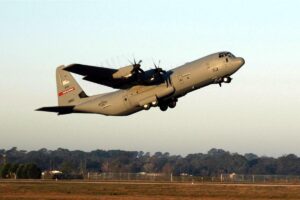MIL-STD-704 Power Supplies: Meeting Avionics Standards
- Introduction
- Understanding MIL-STD-704
- Electrical Power Characteristics
- Importance of Compliance
- Design Considerations for Power Supplies
- Testing and Certification
- Applications in Avionics Systems
- Future Trends
- Conclusion
In military and aerospace applications, the performance and reliability of electrical power systems are of critical importance. The military standard MIL-STD-704 outlines the specifications for aircraft electrical power characteristics to ensure consistent performance and interoperability of onboard systems. It plays a foundational role in enabling equipment from different manufacturers to function harmoniously in the electrically complex environment of an aircraft.
This white paper offers a detailed exploration of MIL-STD-704 and its implications for power supply design and integration. We discuss the standard’s requirements, the challenges in complying with it, and the technological solutions that facilitate effective implementation.
2.1 Overview
MIL-STD-704 defines the electrical interface and characteristics at the terminals of aircraft equipment. It standardizes power formats and ensures that equipment operates effectively under prescribed conditions. This includes both AC and DC electrical power used on military aircraft.
The goal is to guarantee that all components receive stable and predictable electrical input despite the dynamic conditions often encountered during flight operations. The standard addresses voltage levels, frequency, current types, and acceptable tolerances for variations.
2.2 Historical Context
Initially introduced in 1959, MIL-STD-704 was developed in response to the growing complexity of electrical systems aboard military aircraft. Since its inception, it has undergone multiple revisions (from versions A to F) to reflect technological progress and operational needs.
These updates ensure that newer, more sensitive electronic equipment remains compatible with evolving aircraft power systems. It has become the benchmark for military-grade power supply design, ensuring legacy compatibility and future-proof integration.
3.1 Voltage and Frequency Specifications
MIL-STD-704 specifies both AC and DC electrical formats, including their nominal values and allowable variations:
- AC Power:
- 115/200 V, 400 Hz, three-phase power
- Variable frequency systems ranging from 360 to 800 Hz
- 230/400 V, 400 Hz configurations for high-demand applications
- DC Power:
- 28 VDC standard for many avionics systems
- 270 VDC for higher power, reduced weight distribution
These values are carefully chosen to balance efficiency, compatibility, and system stability across different aircraft platforms.
3.2 Power Quality Parameters
MIL-STD-704 does more than just define voltage and frequency. It sets detailed guidelines for power quality, including:
- Voltage transients and sags
- Frequency fluctuation and harmonic distortion
- Phase imbalance and ripple content
- Voltage overshoot and undershoot limits
These parameters ensure that even under transient conditions, such as engine startup or rapid maneuvering, avionics systems remain operational and unaffected.
4.1 Safety and Reliability
Aviation environments are subject to extremes—temperature, altitude, vibration, and electromagnetic interference. MIL-STD-704-compliant power supplies are designed to maintain reliable output in these harsh conditions, reducing the risk of mission-critical system failure.
4.2 Interoperability
MIL-STD-704 standardizes power input across different aircraft systems and components. This allows for equipment from different vendors to be integrated seamlessly, minimizing the need for custom adaptation and improving lifecycle management.
4.3 Mission Success
Ensuring stable and compatible power to avionics systems is critical to mission success. Communication, navigation, weapon control, and surveillance systems all depend on dependable power input. A non-compliant power source could lead to mission failure, data loss, or worse—endanger the aircraft and crew.
5.1 Ruggedness and Durability
Power supplies must withstand mechanical shock, vibration, and thermal cycling. Components need to be ruggedized, often using military-grade materials and construction techniques to prevent failure under duress.
5.2 Redundancy and Fault Tolerance
Redundancy is critical in military aircraft. Power systems must include backup circuitry and failover mechanisms. Fault-tolerant design allows continued operation even when parts of the power supply malfunction.
5.3 Size, Weight, and Power (SWaP)
SWaP optimization is vital. Aircraft space and weight are limited, so power supplies must be compact and lightweight, without compromising performance. Efficiency must be high to reduce heat output and fuel consumption.
5.4 Electromagnetic Compatibility (EMC)
Power supplies must not emit harmful electromagnetic interference (EMI) nor be susceptible to it. MIL-STD-704 works in tandem with standards like MIL-STD-461 to ensure electromagnetic compatibility in avionics environments.
6.1 Compliance Testing
Before being installed in military platforms, power supplies must pass compliance testing. This includes simulations of various operational scenarios to evaluate performance during:
- Overvoltage and undervoltage events
- Load switching
- Transient recovery
- Environmental stress
6.2 Certification Process
Certification involves both laboratory testing and documentation. Independent labs or in-house facilities verify performance metrics, generating test reports. These documents are submitted for review by military procurement agencies or third-party certifiers.
Obtaining certification validates the supplier’s commitment to quality and opens the door to future military contracts.
7.1 Flight Control Systems
Modern fly-by-wire control systems depend heavily on power integrity. MIL-STD-704 ensures that actuators, sensors, and processors receive uninterrupted, clean power—essential for precise aircraft control.
7.2 Communication and Navigation
Secure, long-range communications and accurate GPS-based navigation require high stability in the power domain. Any deviation could introduce latency or signal loss, potentially leading to mission failure.
7.3 Surveillance and Reconnaissance
ISR (Intelligence, Surveillance, and Reconnaissance) systems are power-hungry and require highly reliable sources. MIL-STD-704 ensures these systems operate effectively, delivering real-time battlefield intelligence.
7.4 Electronic Warfare and Weapon Systems
Advanced weapon systems and EW suites rely on MIL-STD-704-compliant power for real-time response and reliability. Malfunctions in these systems due to poor power quality could have devastating consequences.
8.1 Integration of Wide-Bandgap Semiconductors
Power devices based on silicon carbide (SiC) and gallium nitride (GaN) offer increased efficiency and thermal performance. These technologies are gradually replacing silicon-based devices in MIL-STD-704-compliant designs.
8.2 Intelligent Power Management
Smart power distribution units (PDUs) are emerging, capable of monitoring, adjusting, and logging power conditions in real-time. These units can predict and preempt faults, improving mission safety.
8.3 Modular and Scalable Power Systems
Modular systems allow for flexibility in aircraft retrofits and system upgrades. A plug-and-play approach reduces downtime and maintenance complexity while adhering to MIL-STD-704 protocols.
8.4 Cybersecurity and Power Control
Future power systems may include integrated cybersecurity features to protect power management infrastructure from electronic attacks, ensuring data integrity and power availability in hostile environments.
MIL-STD-704 plays a foundational role in ensuring reliable and standardized power delivery in military and aerospace platforms. By dictating precise electrical characteristics and environmental tolerances, it ensures that modern aircraft systems function reliably and safely.
Power supply manufacturers that align their products with MIL-STD-704 not only meet military procurement requirements but also demonstrate a commitment to performance, interoperability, and mission readiness. As technologies evolve, so too will the ways in which this critical standard is implemented, but its core objective—delivering safe, reliable power—will remain constant.





